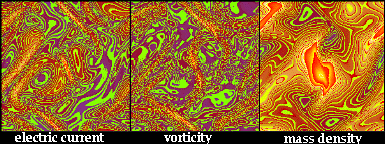

Objective: The objective of this activity is to develop a suite of codes using three types of numerical algorithms and test their applicability on different massively parallel computer architectures. The three are: Fourier transform pseudospectral codes, finite volume/ difference codes, and particle codes. These codes are being written to run on SIMD and MIMD architectures using data parallel and message passing paradigms. These codes will be applied to the physical problem of developing a greater under-standing of the mechanisms that control the behavior of the solar heliosphere and lead to a predictive capability for solar activity.
Approach: There are basically three different paradigms for solving Computational Fluid Dynamics (CFD) problems: Spectral/ Pseudospectral (PS), Finite Volume/ Finite Difference (FD), and Particle codes. There are also basically two paradigms for massively parallel processor (MPP) computer architectures: Single Instruction Multiple Data (SIMD) and Multiple Instruction Multiple Data (MIMD). SIMD architectures favor codes that are inherently parallel in nature whereas MIMD architectures favor codes with distinct blocks of code that can be executed in parallel. In this project we have started with a suite of codes that were optimized to run on single vector processor machines such as the Cray XMP and YMP's and recoded them as necessary to take advantage of the SIMD or MIMD architectures as appropriate. The goal is to develop codes that scale with the number of processors to take advantage of the larger machines as they become available. Since the new MPP machines are potentially faster than previously available machines this has allowed us to become more ambitious in the problems we address and to include increasingly more complex physics packages in these codes as they are being developed. As the codes are developed and the machines become available we are concurrently apply these codes to a variety of scientifically important questions concerning the dynamics of the solar heliosphere and in particular to evolve our understanding of the nature of solar coronal heating and magnetospheric dynamics.
Accomplishments: Four codes have been developed for this project and we have utilized four machines: the thinking machines (TMC) CM-200 (SIMD), the TMC CM-5 (SIMD/MIMD), the Intel iPSC 860 (MIMD) and the paragon (MIMD). We have simulated magnetohydrodynamic turbulent dissipation of the solar corona using our three dimensional pseudospectral code on a 128 cubed mesh on the TMC CM-5. Results from one plane of the simulation are shown in the bottom three panels of the accompanying figure. We have used our 2.5-dimensional (FD) flux-corrected transport magneto-hydrodynamics (FCT-MHD) code to simulate driven magnetic reconnection in solar magnetic structures, a model for chromo-spheric eruptions observed in the Sun's atmosphere. As the shear increases, the X point lengthens into an extended current sheet and mag-netic islands begin to form as the reconnection starts ( upper left panel). At late times, a new quasi-equilibrium state develops with a single, horizontal magnetic island located above the site of the initial X point (upper central panel). This code has demonstrated nearly linear scaling with an estimated 2.5 Gflops on the 256 node TMC CM-5. We have developed a new particle-particle particle-mesh (PPPM) code combining the Monotonic Lagrangian grid (MLG) and particle in cell (PIC) type codes taking advantage of the efficiency on parallel machines of the MLG and the long scale accuracy of the PIC codes. The panels on the upper right show the results of the expansion of a spherical plasma cloud into a vacuum. We have also developed a radiation hydro-dynamics code based on FCT that has demonstrated 3-4 Gflops sustained on the 256 node TMC CM-5.
Significance: Modeling the solar corona involves many different scales of phenomena from the smallest dissipation scales to the largest ideal MHD scales. This requires very large resolution codes in three dimensions. Current computers do not have the speed or memory to resolve all the relevant scales. The MPP archtectures potentially with Teraflop speeds will provide for the first time sufficient power to perform these simulations. Current codes are gearing up to take advantage of these potential speeds. In the meantime with the rapidly advancing computing power we are still able to perform less ambitious but relevant scientific studies.
Status/Plans: Most of our effort to this stage has revolved around the TMC CM-200 and the TMC CM-5 machines. We are planning to put more effort into MIMD machines such as the Intel Paragon and IBM SP-1 and SP-2 as they become available. We plan to continue code development while taking advantage of the available codes to perform scientifically exciting simulations of solar activity.
 Principal Investigator Progress Metric(s)
Principal Investigator Progress Metric(s)
Point of Contact:
 Return to the PREVIOUS PAGE
Return to the PREVIOUS PAGEcurator: Larry Picha (lpicha@cesdis.gsfc.nasa.gov)